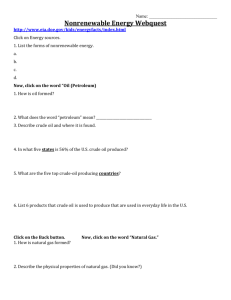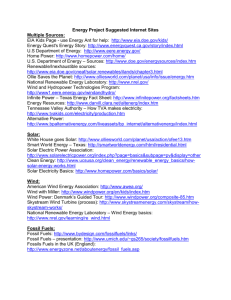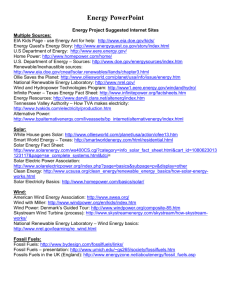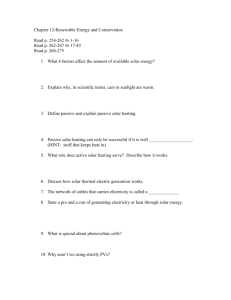2nd Place - World Room
advertisement
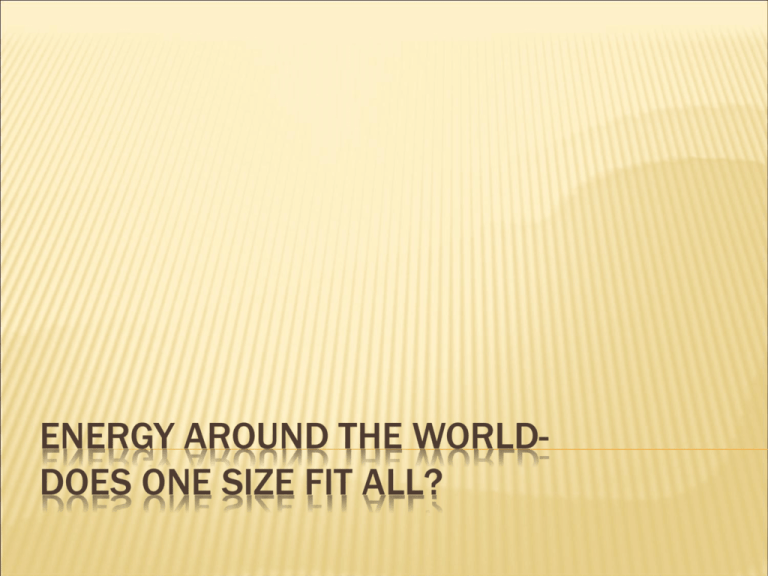
ENERGY AROUND THE WORLDDOES ONE SIZE FIT ALL? WHAT TYPES OF ENERGY ARE AVAILABLE AROUND THE WORLD? BIOMASS Biomass is an organic material made from plants and animals. Biomass can be wood, manure, and even some garbage! Biomass energy is created by burning biomass material. The gases that are released are made into electricity, and the steam it releases can directly heat houses. Some biomass, like garbage, releases methane gas, which is the main ingredient in natural gas. Since natural gas is a nonrenewable resource, we can substitute a renewable resource, like biomass, into a very similar renewable resource. That is better for the environment. Biomass can pollute the air when it is burned, though not as much as fossil fuels can. http://www.worldofenergy.com.au/graphics/photos/factsheet9/types-ofbiomass.jpg NUCLEAR Nuclear energy supplies 16% of the worlds energy. It is created by using a nuclear reactor, and uranium particles are either split or combined to create energy. Nuclear fission is used more than nuclear fusion. Pros- Nuclear energy could produce energy even after fuel and coal run out. Nuclear plants need less fuel than fossil fuel plantsone ton of uranium produces energy that would take several million tons of fossil fuels. Well operated nuclear plants do not pollute. Cons-They produce radiation, which is very harmful to humans if they are exposed. Nuclear explosions can happen if a meltdown occurs- nuclear reactions happen too quickly and too often. The Chernobyl disaster was caused by this happening. If nuclear wastes are not stored correctly they can result in explosions, just like if they were in use. http://www.dancewithshadows.com/business/wpcontent/uploads/2008/09/nuclear-energy-gmr.jpg http://www.our-energy.com/chernobyl_disaster.html HYDROGEN Hydrogen is the most plentiful gas in the universe. It is a simple element, and it only exists as a solid compound when combined with other elements on Earth. To make hydrogen into a form of energy, we must first separate it from the other bonds in the compound it is in. Next it is turned into a gas by steam reforming or electrolysis. Then it is ready to be turned into energy! Hydrogen is usually turned into a fuel cell, although it can be used once it is in its pure hydrogen gas state. Every region in the world has some type of material that can be used to process hydrogen, and this makes this type of energy very accessible. Hydrogen can power everything from cars to homes to laptop computers. It is also a very clean source of energy and does not emit any type of fume or vapor. http://www.eia.doe.gov/kids/energyfacts/sources/Inter mediateHydrogen.html There’s even a hydrogen powered cell phone! http://www.inhabitat.com/wpcontent/uploads/angstrom-hydrogen.jpg WIND In this form of energy, wind turns the turbine. The blades turn a shaft inside the nacelle (the box at the top). The shaft goes into the gear box which increases the rotation speed enough for the generator to convert rotational energy into electric energy using magnetic fields. Pros- Wind is free, and wind farms don’t need to use any fuel! Wind energy produces no waste or greenhouse gases, and the land beneath the turbines can still be used. Cons- On some days there is no wind, so a backup energy source is needed. Although it is extremely rare, birds can be killed by the turbines. Sometimes the turbines are noisy, but that too is rare. http://blogs.mysanantonio.com/weblogs/clockingin/2009/01/valero-hasfired-up-phase-one.html HYDROELECTRIC Hydropower is one of the most used forms of energy in the US today. Hydroelectricity is made from deriving mechanical energy from flowing water. This is often accomplished by building a dam to collect water. The amount of available energy from water is determined by its flow and fall. Water that runs very fast or falls a great distance is the most suitable for use as hydropower energy. When the water is inside the dam, it turns a wheel, called a penstock, which in turn produces electricity in a generator on the shore. Hydropower is a great form of energy because it costs almost no money. There are no waste by-products, and it does not pollute the water or the air. http://www.promotega.org/AAU06004/Hydroelectricity_files/image002.jpg http://www.radford.edu/%7Ewkovarik/envhist/RenHist/2.water.pix/itaipu.better .jpg COAL Pros- It is inexpensive and if in great supply, very reliable. It provides about half of the United States' energy. Cons- The burning of coal is one of the least environmentally friendly energy sources, leaving its large mark on planet Earth. It is nonrenewable, so when it is gone, it is gone for good, and can take several hundred million years to form again. Burning coal produces more carbon dioxide than burning oil or natural gas, and the fumes contribute to acid rain. http://www.the-coalman.co.uk/images/coal.jpg http://www.enviroblog.org/2007/0 3/coal-combustion-facescontroversy.html OCEANIC There are many types of oceanic energy. They are: Tidal Wave Water/Solar Water/Wind These types of energy are useful because they use water, which is plentiful, to harvest electricity in a non-impact way. OCEANIC-CONTINUED Tidal- Like wind energy, tidal energy is produced with the use of a turbine. In the tidal system, there are many turbines placed parallel to each other. All of the water that passes the turbines is forced through them, and this spins a wheel which in turn generates electricity. Tidal turbines are clean and can be used anywhere with a tide range above 10 feet, but they are expensive and may harm plant and animal life. Wave- Waves are huge sources of energy. We can use this energy by bending the waves into a channel, increasing their size, and then using the water to spin turbines to generate electricity. This form of energy could be used anywhere large waves break near the shore and would be useful for the West Coasts of the US and Europe and in New Zealand and Japan. Both Pictures are from: http://www.eia.doe.gov/kids/energyfacts/sources/renewable/o cean.html OCEANIC-CONTINUED Water/Solar Energy- Since the ocean makes up 70% of the surface of Earth, why not put a solar farm on the top of the ocean? Solar panels would be placed just offshore to collect solar energy. Then the panels would transmit energy to the land to be used. Water/Wind Energy- This type of energy can be used everywhere along the coast of the US. It is just like a continental wind farm, where wind turbines are placed to change wind into energy. Some people oppose this because it would change the view of the ocean. http://64.202.120.86/upload/image/new-news/2008/fabruary/unlimited-solar-energyfrom-the-ocean/sea-solar-power-plant-2.jpg http://ecology.com/ecology-today/wp-content/uploads/2008/11/ocean-wind-powernasa.jpg NATURAL GAS Pros- Natural gas is efficient, economical, and reliable. Remember how your gas stove worked when the power went out? Cons- It is less environmentally friendly than other alternatives, but friendlier than oil and coal energy. Because it is nonrenewable, when it is gone, it is gone. This could make demand much higher in the future, making the price skyrocket. http://laclarongeblog.blogspot.com/2007/03/natural-gas-comes-north.html http://www.naturalgas.org/naturalgas/naturalgas.asp SOLAR Solar energy is an excellent and environmentally friendly energy source for areas of the world that receive large amounts of sunlight. It can be used to heat water and spaces. Solar energy is generated using two types of panels- photovoltaic cells, which are the kind you see on houses and are not connected to a power grid, and cells connected to power plants. Pros- It is environmentally friendly, very accessible and useful in sunny areas. Renewable Cons- Solar panels are expensive to install and maintain, which limits the amount of countries that could benefit from it. Solar panels can only work when it is sunny, so it can be used in limited areas where sunshine is great enough for the solar cells to be profitable. http://www.agpe-energy.com/SOLAR_ENERGY.html http://www.treehugger.com/files/2006/10/selling_solar_t.php GEOTHERMAL Geothermal energy is derived from the same force that builds mountains, erupts volcanoes, and is responsible for hot springs. Geothermal energy is sourced from geothermal reservoirs, which can be found in few areas. California could benefit from geothermal energy because of their fault lines, where geothermal reservoirs are normally found. Pros- Environmentally friendly- they produce no smoke, only steam, and they are cost efficient. Renewable. Cons- Only available in select places. Both Pictures are from; http://geothermal.marin.org/pwrheat.html OIL The US produces only 40% of the total amount of oil it uses. The top oil producing countries are Saudi Arabia, Russia, and the United States. Pros- Low cost, compact generators, easy to store and transport. Cons- Oil is nonrenewable and being used at a fast rate, it is a source of conflict trading wise, and when in transport, oil can spill causing great environmental strain. http://ecotechdaily.com/2008/05/06/oil-prices-rise-again-on-200-warning/ The dangerous effects of an oil spill http://www.appvoices.org/images/galleries/MartinCountyNastySpill.jpg WHERE CAN THESE TYPES OF ENERGY BE FOUND AND WHY ARE THEY USEFUL? BIOMASS Accessible all over the world 70-90 percent of people in Africa use wood, a biomass material, to heat their homes 50-60 percent of all developing countries in Asia use biomass Clean Cost-effective, and anyone can have their own biomass NUCLEAR Virtually can be used in any part of the world Limited to countries that can afford it Cost in excess of $13 billion Japan, Russia, the United States, Korea, and China have all harnessed nuclear energy Sometimes nuclear energy is not used to benefit, like in WWII HYDROGEN Abundantly located in every region of the world. Very clean form of energy Likely to be used in countries with a substantial amount of money, because the whole process is somewhat expensive US, China, Japan, India, and other countries may be the pioneering forces in making this energy available to everyone. WIND Can be used in places with wind speeds of over 10 mph. Can withstand 140 mph winds Mostly found around the coast or in desert or plain areas Wind energy is cost effective, but installation is expensive Most always found in rural areas, would take up too much space in the city HYDROELECTRIC Best used in mountainous areas with rivers, or areas with rivers in general Many places in Africa, the Middle Sast, Siberia, and Asia may not be able to access this form of energy Europe, Canada, South America, the USA and other areas of the world are well suited for hydroelectricity COAL Can be harnessed where it is found or imported. People are choosing more environmentally friendly alternatives. Remains the cheapest, and supplies many American and world wide households OCEANIC Useful to countries and states located on the ocean or any other large body of water Wave and tidal energy are the only exceptions to that rule, because they require substantial amounts of change in sea level and waves must break close to the shore to generate a high amount of electricity These forms of energy would be helpful to poorer countries, because they are all relatively inexpensive NATURAL GAS Can be used where it is found or imported. Like coal, it is cost effective. India, the United States, Canada, and Russia all use natural gas in great amounts. SOLAR Very smart energy choice in sunny parts of the world: countries on the equator, India, Alaska, Arizona, or Hawaii etc. Island nations could benefit from solar energy. Panels can be expensive if put on a large area, so some countries, or cities could not use them GEOTHERMAL Can only be used in a small part of the world where geothermal reservoirs are found. Includes: countries surrounding the Ring of Fire, the Philippines, Alaska and California. Has also been used in Europe. OIL Can be used anywhere in the world. Creates a significant amount of pollution, countries or states with large amounts of pollution might use a more environmentally friendly alternative. Oil is one of the best choices for poor countries. WORKS CITED "BWEA - How Does Wind Energy Work?." BWEA: Delivering UK wind, wave and tidal energy. 12 Apr. 2009 <http://www.bwea.com/energy/how.html>. Baskind, Chris. "Oil Prices Rise Again on $200 Warning | EcoTech Daily." EcoTech Daily | Green technology, gadgets & news. 19 May 2008. 13 Apr. 2009 <http://ecotechdaily.com/2008/05/06/oil-prices-rise-again-on-200-warning/>. "Chernobyl disaster - Our energy." Home - Our energy. 13 Apr. 2009 <http://www.our-energy.com/chernobyl_disaster.html>. "Coal Image." The Coalman. 13 Apr. 2009 <www.the-coalman.co.uk/images/coal.jpg>. "Department of Energy - Coal." Department of Energy - Homepage. 13 Apr. 2009 <http://www.energy.gov/energysources/coal.htm>. "EIA Kids Page - Energy from the ocean: tidal energy, wave energy." Energy Information Administration - EIA - Official Energy Statistics from the U.S. Government. 8 Apr. 2009 <http://www.eia.doe.gov/kids/energyfacts/sources/renewable/ocean.html>. EWG. "Enviroblog: Coal combustion faces controversy Archives." Enviroblog. 19 Mar. 2009. 13 Apr. 2009 <http://www.enviroblog.org/2007/03/coal-combustion-faces-controversy.html>. "Energy Resources: Home page." c l a r a . n e t - Customer Index. 14 Apr. 2009 <http://home.clara.net/darvill/altenerg/index.htm>. "Fossil Fuels and Coal." The Energy Story. 13 Apr. 2009 <www.energyquest.ca.gov/story/chapter08.html>. "Geothermal Education Office." Geothermal Education Office. 11 Apr. 2009 <http://geothermal.marin.org/>. "Hydroelectric Dam." Radford. 8 Apr. 2009 <www.radford.edu/%7Ewkovarik/envhist/RenHist/2.water.pix/itaipu.better.jpg>. "Hydrogen - Energy." Energy Information Administration - EIA - Official Energy Statistics from the U.S. Government. 8 Apr. 2009 <http://www.eia.doe.gov/kids/energyfacts/sources/IntermediateHydrogen.html>. WORKS CITED-CONTINUED "Hydropower - Water Energy." Energy Information Administration - EIA - Official Energy Statistics from the U.S. Government. 8 Apr. 2009 <http://www.eia.doe.gov/kids/energyfacts/sources/renewable/water.html>. "Lac La Ronge and Area Blog." Lac La Ronge and Area Blog. 13 Apr. 2009 <http://laclarongeblog.blogspot.com/2007/03/natural-gascomes-north.html>. "NaturalGas.org." NaturalGas.org. 13 Apr. 2009 <http://www.naturalgas.org/naturalgas/naturalgas.asp>. ”.Petroleum - Wikipedia, the free encyclopedia." Wikipedia, the free encyclopedia. 14 Apr. 2009 <http://en.wikipedia.org/wiki/Petroleum>. "Renewable Energy - Biomass including wood, MSW, and biofuels, carbon cycle, photosynthesis." Energy Information Administration - EIA Official Energy Statistics from the U.S. Government. 7 Apr. 2009 <http://www.eia.doe.gov/kids/energyfacts/sources/renewable/biomass.html>. "Renewable Energy and Sustainable Development." Solar Energy Society of Canada. 29 Nov. 1997. 7 Apr. 2009 <www.newenergy.org/sesci/publications/pamphlets/renewable.html>. "Solar Energy." AGPE Energy. 13 Apr. 2009 <http://www.agpe-energy.com/SOLAR_ENERGY.html>. "The Pros and Cons of Various forms of Generating Electricity." The Ramblings of a Bush Philosopher. 12 Mar. 2009. 13 Apr. 2009 <geocities.com/daveclarkecb/ElecGenProsCons.html>. Thomas, Justin. "Home Depot Selling Solar to Mainstream America : TreeHugger." TreeHugger. 24 Oct. 2006. 13 Apr. 2009 <http://www.treehugger.com/files/2006/10/selling_solar_t.php>. Vaughan, Vicki. "Mckee Wind Farm." My San Antonio Blogs. 22 Jan. 2009. 13 Apr. 2009 <blogs.mysanantonio.com/weblogs/clockingin/2009/01/valero-has-fired-up-phase-one.html>. "World of Energy-Biomass Fact Sheet." World of Energy. 8 Apr. 2009 <http://www.worldofenergy.com.au/factsheet_biomass/07_fact_biomass_what.html>.

